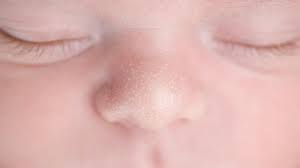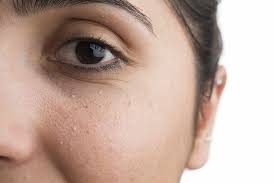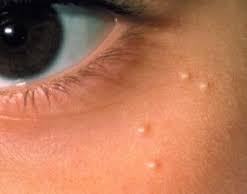Milialar form when the protein keratin becomes trapped under the skin. This may be caused by certain medical conditions or skin products. This often happens in groups. Multiple cysts are called milia.
Milialar form when keratin becomes trapped beneath the skin’s surface. Keratin is a powerful protein normally found in skin tissue, hair and nail cells. Milialar can occur in people of all races and ages. However, it usually occurs in newborn babies.
Read on to learn more about milialar, its causes and treatments.

Milialar are small, dome-shaped bumps that are usually white or yellow in color. There is usually no itching or pain. However, this may cause discomfort for some people. Rough sheets and clothing can cause milialar to become inflamed and appear red.
Cysts are commonly found on the face, lips, eyelids, and cheeks. However, it can also be found in other parts of the body, such as the torso and genitals. These are often confused with a condition called Epstein pearls. In this condition, harmless white-yellow cysts start appearing on the gums and mouth of the newborn. Milialar is often erroneously referred to as “baby acne.”
The cause of milialar in newborns is unknown. It is often confused with baby acne, which is caused by the mother’s hormones. Unlike baby acne, milialar does not cause inflammation or swelling. Babies with milia are usually born with it, but baby acne doesn’t appear until 2 to 4 weeks of age.
How many types of milialar are there?
The types of milialar are classified according to the age at which the cyst appears or the reason the cyst develops. These types are also classified into primary or secondary categories.
Primary milialar are formed from tightly packed keratin. These cysts are usually found on the faces of infants or adults.
Secondary milialar look similar but form when something blocks the passage to the skin surface, such as after trauma, a burn, or a blister.
Neonatal Milia
Milia in newborns is considered primary milialar. It occurs in newborn babies and disappears within a few weeks. Cysts usually appear on the face, scalp, and upper body. According to Seattle Children’s Hospital, up to 40% of newborns develop milia.
Primary milialar in older children and adults
Cysts are found around the eyelids, on the forehead, and on the genitals. Primary milialar may disappear within a few weeks or persist for several months.

Milialar and Plaque
This condition is often associated with genetic or autoimmune skin diseases, such as lupus disciformis or lichen planus. Milia can affect the eyelids, ears, cheeks, and jaw. The cyst may be several centimeters in diameter. It occurs primarily in middle-aged women, but can also occur in adults and children of any age and gender.
Multiple Eruptive Milialar
This type of milialar is an itchy patch that appears on the face, upper arms, and torso. Cysts often appear over weeks to months.
Here are some key characteristics of milialar:
Appearance: Milia are usually small, dome-shaped bumps with a white or yellowish color. They may appear similar to whiteheads, but they are not associated with hair follicles.
Location: Milialar are often found on the face, particularly around the eyes, nose, and cheeks. They can also occur in other parts of the body.
Causes: Milialar are typically formed when dead skin cells become trapped in small pockets on the skin’s surface. They can also develop after skin trauma, such as burns or blistering.
Treatment: In many cases, milialar do not require treatment and may resolve on their own over time. However, if they persist or are bothersome, a dermatologist may be able to extract them using a sterile needle or other procedures.
Painful Milialar
These cysts develop where the skin has been damaged. Examples include severe irritation and skin rashes. The cyst may be swollen and red around the edges and white in the center.

Milialar related to drugs or products
Using steroid creams can cause milialar to develop when the cream is applied to the skin. However, this side effect is rare.
Some ingredients in skincare and makeup products can cause milialar in some people. If your skin is prone to milia, avoid the following ingredients:
(a) Liquid paraffin
(b) Liquid petroleum
(c) Paraffin oil
(d) Paraffin Liquid
(e) vaseline liquid
(f) Oil
These are all types of mineral oils that can cause milialar. Lanolin may also increase the formation of milialar.
How is Milialar treated?
Milialar in infants does not require treatment. The cysts usually disappear within a few weeks. In older children and adults, milialar disappear within a few months. If these cysts cause discomfort, there are treatments that can effectively remove them. they include:
Cryotherapy. Liquid nitrogen freezes the milialar. This is the most commonly used deletion method. Removing the roof. Remove the contents of the cyst with a sterile needle.
Topical retinoids. These Vitamin A-rich creams help in exfoliating the skin.
Chemical peel. With a chemical peel, the first layer of skin is removed to reveal new skin.
laser ablation. A small laser focuses on the affected area and removes the cyst
Diathermy. Excessive heat destroys the cyst. Devastating treatment. The cyst is surgically scraped off and cauterized.
Read Also: Is Sting Energy Drink Healthy
What are the possibilities?
Milialar does not cause long-term problems. In newborn babies, cysts usually disappear within a few weeks of birth. Although the process may take longer in older children and adults, milialar are not considered harmful.
If your condition does not improve within a few weeks, consult your doctor. You can rest assured that this is not any other skin disease.